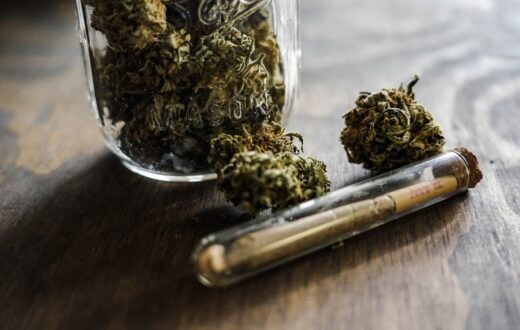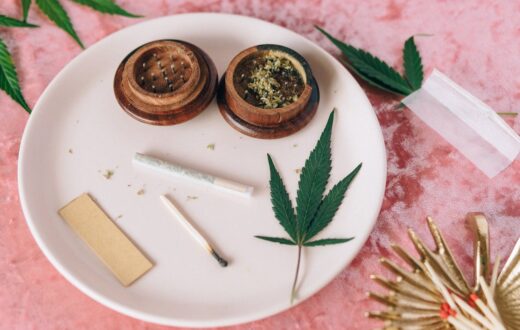Introduction to the AK 47 Strain
The AK 47 strain is a renowned hybrid cannabis strain that has captured the attention of growers and consumers alike due to its distinct characteristics and effects. Originating in the late 1990s, this strain combines a mix of landrace genetics, notably from Mexican, Thai, Afghan, and Colombian strains. Its diverse genetic makeup contributes to its robust resilience and adaptability, making it a preferred choice for many cannabis cultivators. As a result, learning how to grow AK 47 weed strain has become a popular pursuit for both novices and seasoned growers.
One of the remarkable features of the AK 47 strain is its balanced hybrid nature, comprising approximately 65% Sativa and 35% Indica. This balance results in a pleasantly euphoric and uplifting experience that is sought after by users looking to alleviate stress, anxiety, and depression. The strain is characterized by its robust buds adorned with a dense layer of glistening trichomes, which not only signify potency but also contribute to an appealing aesthetic. Furthermore, these buds emit a sweet and earthy fragrance, making them attractive to growers aiming for quality cannabis.
The popularity of the AK 47 strain can also be attributed to its relatively easy cultivation process. It thrives in both indoor and outdoor environments, offering flexibility for growers of varying experience levels. Its flowering time ranges from 7 to 9 weeks, relatively prompt compared to other strains, allowing for multiple harvests throughout a growing season. With proper care, the potential yields can be quite generous, further incentivizing growers to experiment with this specific strain. Overall, understanding how to grow AK 47 weed strain is vital for anyone looking to achieve an impressive and satisfactory cultivation experience.
Ideal Growing Conditions for AK 47
When considering how to grow AK 47 weed strain successfully, understanding the ideal growing conditions is paramount. This hybrid cannabis strain thrives under specific environmental factors that can significantly affect its development, yield, and potency. Foremost among these factors are temperature, humidity, light exposure, and soil type.
The optimal temperature range for growing AK 47 is typically between 70°F and 85°F (20°C to 30°C) during the day. Nighttime temperatures should be slightly cooler, ideally between 60°F and 70°F (15°C to 20°C). Such temperature regulation is essential as extreme heat or cold can adversely impact plant health and cannabinoid production. Maintaining a stable environment free from drastic fluctuations will help the plants grow vigorously, ultimately leading to a more robust yield.
Humidity levels also play a critical role in the growth of AK 47. During the vegetative stage, a humidity level between 40% and 70% is recommended. However, as plants transition to the flowering phase, humidity levels should be gradually lowered to around 40% to prevent mold and bud rot. Controlling humidity is vital not only to promote healthy growth but also to ensure the quality of the final product.
Light exposure is another critical factor in determining how to grow AK 47 weed strain effectively. This strain flourishes under full-spectrum light, especially during its flowering period. Indoor growers often utilize high-intensity discharge (HID) or light-emitting diode (LED) lights, while outdoor cultivators should ensure that the plants receive ample sunlight throughout the day, ideally at least 12 to 14 hours of direct light during the flowering phase.
Lastly, selecting the right soil type can influence nutrient uptake and growth speed. AK 47 thrives in well-draining soil that is rich in organic matter. A pH level between 6.0 and 7.0 is ideal for optimal nutrient absorption. By creating a controlled environment that caters to these ideal growing conditions, cultivators can maximize both yield and the overall quality of the AK 47 weed strain.
Seeds and Clones: Choosing the Right Start
When considering how to grow AK 47 weed strain, one of the first decisions is whether to start with seeds or clones. Each option has its own advantages and disadvantages, which can significantly influence the growth process and the final yield. Understanding these factors is crucial for anyone who wants to cultivate this renowned cannabis strain.
Starting with seeds is often regarded as the more traditional method. Seeds generally offer a greater genetic diversity, providing growers with the opportunity to cultivate various phenotypes. This can be particularly advantageous for those aiming to explore different characteristics within the AK 47 lineage. Moreover, seeds often have a longer shelf life compared to clones, making them more accessible for future grows. However, one of the cons is that germination may take longer, and not all seeds will produce plants of the same quality due to potential instability in genetics.
On the other hand, clones are cuttings taken from a mother plant, ensuring that the new plants have the same genetic makeup as the parent. This means that if the mother exhibits desirable traits, the clones will likely do so as well. Cloning offers a quicker route to growth, as established plants usually transition into flowering faster than seedlings. However, the downside of clones includes their dependency on the health and quality of the mother plant, as any disease or deficiency can be transferred to the new plants. Additionally, clones may also be harder to find, particularly for specific strains like AK 47.
Ultimately, the choice between seeds and clones when learning how to grow AK 47 weed strain hinges on individual preferences and circumstances. Those seeking stability and quicker harvests may prefer clones, while those interested in genetic variety and exploration might lean toward seeds. Assessing growth goals, availability, and resources can aid in making the best selection for an effective growing endeavor.
Nutrients and Feeding Schedule
Growing the AK 47 weed strain successfully largely depends on providing the right nutrients throughout its life cycle. Essential macronutrients for cannabis plants include nitrogen (N), phosphorus (P), and potassium (K), which are crucial for promoting healthy growth and development. Additionally, micronutrients such as calcium, magnesium, iron, and manganese play a vital role in the overall health of the plants. A balanced supply of these nutrients ensures that the plants remain vigorous, which is particularly important for the AK 47 strain, known for its robust characteristics.
The feeding schedule should be meticulously planned to accommodate the various growth stages of the AK 47 weed strain. During the seedling phase, it is recommended to start with light nutrient solutions, focusing primarily on nitrogen, as young plants need this nutrient for lush foliage. As the plants transition into the vegetative stage, more nitrogen should be introduced to support leaf development and vigorous growth, typically at a concentration of 300-400 ppm (parts per million).
When the AK 47 plants shift into the flowering stage, the nutrient mix should be altered to increase phosphorus and potassium levels while reducing nitrogen, promoting flowering and bud development. A standard feeding schedule may involve feeding every one to two weeks, adapting based on how the plants respond. Observing the green color and general vigor can help gauge nutrient adequacy.
Growers may choose between organic and synthetic nutrient options based on preference and budget. Organic fertilizers, such as compost teas and fish emulsion, provide slow-release nutrition, encouraging healthy soil organisms. In contrast, synthetic fertilizers offer a quicker nutrient uptake, which may lead to robust growth but can risk over-fertilization if not carefully monitored. Whichever approach is taken, the key to how to grow AK 47 weed strain effectively lies in observing the plants’ responses and adjusting the feeding accordingly.
Training Techniques for Maximum Yield
When it comes to successfully cultivating the AK 47 weed strain, incorporating effective training techniques is crucial to maximizing yield. Two commonly employed methods are Low-Stress Training (LST) and High-Stress Training (HST). Each method has its distinct advantages, and growers can choose the most suitable one based on their growing conditions and experience level.
Low-Stress Training involves gently bending or tying down branches to promote horizontal growth. This method allows light to penetrate more evenly across the plant, ensuring that the lower buds receive sufficient exposure. To implement LST, start in the early vegetative stage. Use soft ties or garden wire to secure the branches at a downward angle, gradually allowing the plant to spread out. By doing so, you encourage multiple colas to form, leading to a potentially greater overall yield.
On the other hand, High-Stress Training can be a more aggressive approach. This includes techniques like topping, where the main stem is cut to encourage the growth of side branches. Topping an AK 47 can lead to bushier plants with multiple colas, which can significantly increase yield. Be cautious with HST, as it can cause temporary stress to the plant; however, the long-term benefits often outweigh the initial shock, especially for experienced growers who know how to nurture their plants post-training.
Regardless of the technique chosen, proper timing is critical. Training should typically begin once the plant has established a healthy root system and has reached a manageable height. Additionally, it is important to monitor the plant’s response after training; adjusting methods based on the plant’s health can lead to optimal results. By applying these training techniques effectively, growers will find themselves on the right path to achieving a bountiful harvest of AK 47 weed strain.
Pest and Disease Management
Growing the AK 47 weed strain can be rewarding, but it is crucial to be vigilant about potential pests and diseases that may impede its growth. Common pests that affect this strain include spider mites, aphids, and thrips, all of which can significantly damage the plant’s leaves and overall health. To prevent these pests, regular inspections are essential. Look for signs such as discolored or stunted leaves, which indicate an infestation. Early detection allows for timely intervention and minimizes damage.
To combat pests effectively, Integrated Pest Management (IPM) strategies can be employed. This method emphasizes a combination of biological control, cultural practices, and mechanical controls. For example, introducing beneficial insects like ladybugs can help naturally reduce populations of harmful pests. Additionally, maintaining good airflow and avoiding overcrowding can reduce the likelihood of pest infestation, as many pests thrive in stagnant conditions.
In terms of diseases, AK 47 is susceptible to powdery mildew and root rot. Proper watering techniques and humidity control are vital for preventing these issues. Ensuring that the soil drains well and using quality potting mixes can help mitigate the risk of root rot. Moreover, rotating crops and practicing good sanitation by cleaning tools and containers can minimize the spread of diseases. If a disease does manifest, organic solutions such as neem oil or potassium bicarbonate can be effective in treatment.
Ultimately, adopting a proactive approach towards pest and disease management is essential for cultivating a healthy AK 47 weed strain. By implementing preventative measures and utilizing organic pesticide options when necessary, growers can maintain a thriving environment for their plants and enhance their yield.
Identifying the Right Time to Harvest AK 47
Determining the optimal time to harvest AK 47 weed strain is crucial for achieving the best flavor, potency, and overall quality of the buds. The primary indicator for readiness is the development of trichomes, which are small, crystal-like formations on the buds and leaves. Using a magnifying glass or jeweler’s loupe, examine these trichomes closely. When they appear clear, the cannabis is not yet ready for harvest. As they mature, trichomes will turn milky white, indicating peak potency. For those seeking a more sedative effect, waiting until around 20% of the trichomes become amber may be beneficial. In contrast, harvesting when most trichomes are milky will yield uplifting effects, characteristic of the AK 47 strain.
Proper Harvesting Techniques
Once the trichomes indicate that it is time to harvest AK 47, proper techniques must be employed to ensure minimal damage to the plant and to preserve the quality of the buds. Begin by preparing your tools, which should include sharp, sterile scissors or pruning shears to avoid tearing the plant. Before cutting, it is advisable to reduce the light exposure to the plants 24 hours prior to harvesting. This practice can enhance the potency by reducing the production of chlorophyll. When ready, carefully trim the larger fan leaves followed by the smaller leaves closely around the buds. This process, known as trimming, helps to improve the drying process and enhances the final product’s appearance.
Post-Harvest Considerations
After harvesting the AK 47 weed strain, considering the post-harvest drying and curing processes is essential. Ideally, the buds should be hung upside down in a dark, well-ventilated space with humidity levels around 50-60%. This environment allows the buds to dry uniformly, minimizing the risk of mold. Once the buds feel dry on the outside but still slightly moist inside, they can be moved into glass jars for the curing process. Curing allows for further enhancement of flavor and potency, creating a more enjoyable experience for consumers. By meticulously following harvesting and post-harvest guidelines, growers can maximize the potential of their AK 47 yield.
Curing and Storing Your Harvest
Curing is an essential step in the post-harvest process of the AK 47 weed strain, aimed at enhancing its flavor, aroma, and potency. Once the plants are harvested, it is crucial to hang them upside down in a controlled environment with temperatures between 60-70°F (15-21°C) and humidity levels at around 50-60%. This process can take about 7 to 14 days, depending on the density of the buds. Proper air circulation is vital during this phase to prevent the growth of mold while allowing the chlorophyll to break down, which contributes to a smoother smoke.
After the drying process, the buds should feel dry on the outside but still retain some moisture on the inside. The next step is to place the buds in airtight containers for curing, allowing them to age gracefully and develop more complex flavors. Keeping the containers in a cool, dark place can significantly enhance the overall quality of the harvest. It is advisable to open the containers for a brief while each day during the first week, allowing fresh air to circulate within. This process, often referred to as “burping,” helps to regulate humidity levels and prevents any potential moisture buildup, which could lead to unwanted mold or mildew.
For long-term storage of your AK 47 weed strain, consider using glass jars, vacuum-sealed bags, or specialized cannabis storage containers. Glass jars are particularly popular as they are airtight and do not impart any unwanted chemicals, preserving the integrity of the weed. Ensure that the containers are stored in a cool, dark place, away from direct sunlight, to maintain the potency and freshness of your harvest. By following these guidelines on how to grow AK 47 weed strain, as well as caring for your harvest, you can significantly improve your smoking experience and enjoy the full benefits of your crop.
Conclusion and Final Tips
In conclusion, successfully cultivating the AK 47 weed strain requires attention to detail and a commitment to understanding its specific needs. Throughout this guide, we have explored the essential factors that contribute to optimal growth, including selecting the right environment, managing nutrients, controlling humidity and temperature, and the importance of proper lighting. Each of these elements plays a crucial role in promoting healthy plant development and maximizing yield.
For those looking to grow AK 47, one key tip is to maintain a balanced nutrient regimen, as this strain thrives with a careful mix of nitrogen, phosphorus, and potassium. Regular monitoring of the pH levels in the soil or hydroponic system will also ensure that the roots can absorb vital nutrients effectively. Additionally, consider employing various training techniques, such as topping or low-stress training (LST), to enhance yield and improve light penetration throughout the canopy.
Another vital consideration when deciding how to grow AK 47 weed strain is the timing of the flowering phase. Recognizing when to induce flowering can significantly impact the final product’s potency and overall health. Growers should observe their plants closely and adjust their care routines accordingly, responding to any signs of distress.
Finally, sharing experiences and learning from one another can greatly enhance the overall growing journey. Many growers find community support invaluable, as it allows them to adapt various techniques to fit their unique circumstances, improving their cultivation results. By staying informed and being open to new approaches, you can perfect your methods as you continue to learn how to grow AK 47 weed strain effectively. Happy growing!












